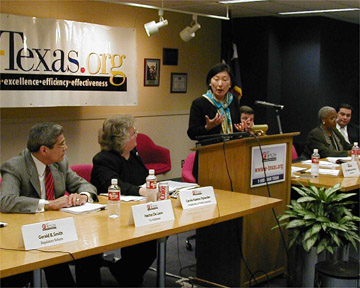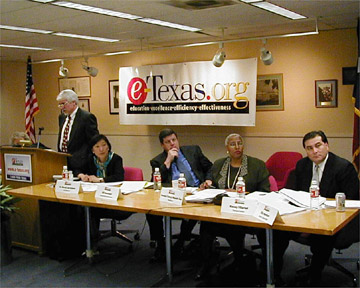|
April 3, 2000
Full e-Texas Commission Meeting
Members Present
Comptroller Carole Keeton Rylander, Deputy Comptroller Billy Hamilton, Co-Chairman Hector De Leon, Co-Chair Dr. Wendy Gramm, Commissioners Bill Hammond, Ro Parra, John Fainter, Sonny Messiah-Jiles, Massey Villarreal,
Background
The e-Texas commission is made up of 14 task force members and three co-chairs. The three co-chairs are: Hector De Leon, Dr. Wendy Gramm and Tom Leoffler. Commissioners include: Senator Robert Duncan, Kevin Eltife, John Fainter, Noe Fernandez, Bill Hammond, Tom Hicks, Laura Ayoub Keith, Elizabeth Lang-Miers, Sonceria Messiah-Jiles, Charles Miller, Ro Parra, Thomas Saving, Gerald Smith, and Massey Villarreal.
Executive Summary
Dr. Gramm called the meeting to order, then turned over the meeting to Comptroller Rylander for opening remarks. Comptroller Rylander said that Monday's e-Government hearing was the 6th e-Texas hearing held to date—previous hearings were held on education (2), transportation (2), and competitive government. She also explained that the TxDOT Performance Review, which has been rolled into e-Texas, had its third hearing cancelled March 29 due to the tornadoes that hit Fort Worth and the surrounding area. That hearing is expected to be rescheduled soon.

Co-Chairman Hector De Leon said that the diversity of the population of Texas will benefit e-Texas and that this diversity will drive the engine of e-Texas. He thanked the volunteers' efforts and noted that e-Texas could not happen without the help and cooperation of the volunteers.
Dr. Gramm opened her remarks with discussion of the new economy, technology is the third wave much like that of the Industrial Revolution, the new economy is the Information Revolution. She added that regulations should not stifle innovation, and government should move towards a more customized approach of doing business, not a "one-size fits all" approach.
Deputy Comptroller Billy Hamilton mentioned that other states are watching what Texas is doing. Therefore, it is essential for the various task forces to see and receive the proper information in order to make the best possible recommendations for the Legislature.
He noted some e-Texas-related programs taking place under Comptroller Rylander. First, the Comptroller's office is launching the Texas IT Academy that will provide technical training for people wanting to enter the high-tech workforce. In return, those trainees will agree to work for the State of Texas for two years. This pilot project is recruiting now, and training begins this summer. He added that the Comptroller's office is moving to online tax filing which should be available for use this summer, zero-tax filing can already be filed electronically. The Comptroller's office has awarded its first "Point with Pride" award, an award given for outstanding innovation and implementation of technology in an effort to move toward a smaller, smarter government. It was awarded in Abilene to the Region XIV Education Service Center for its new education technology that allows high school students to take college-level classes without leaving their home campus.
Bill Eggers, e-Texas project manager, discussed trends driving government changes. Those trends include, Internet and e-government, recruitment problems and aging of the workforce, performance measurement and accountability movement, increased demands from taxpayers, globalization and increased outsourcing, and partnerships. He added that themes for the 21st Century government include: digital, customized, networked, market-based, outcome-based and decentralized. Eggers said government should be citizen-centered—by the individual, for the individual. Constituents want 24-hour service, increased choices and seamless government, he said.
Discussion
Four primary issues were discussed at the commission meeting:
- Economic trends and indicators
- Economic growth
- Tax policy, and
- Budget drivers
Mike Reissig, director of estimates for the Comptroller's Office, discussed Texas economic trends and indicators. He noted five themes in the new economy:
- Work with your brain more exclusively
- Global competition and the importance of exports
- Innovation is more important than mass production, the job growth is in more specialized industries such as technology, and research and development
- Rapid change is constant—increase in growth, increase in jobs and increase in rate of change
- Don't know exactly how to measure new economy
Reissig noted the increase in more technology-based exports and industries in Texas. However, he added that traditional industries such as oil and gas remain very important.
Don Hoyte, deputy manager of strategic research for the Comptroller's Office, presented information regarding economic growth strategies and Texas and the new economy. He said the new economy is different than the old in that the new is global, intensely inter-linked and is about intangibles like ideas, information and relationships.

In the new economy, ideas and information represent supply while networks represent demand. Supply, in the new economy, has a downward sloping supply curve due to society's ability to multiply ideas at no extra cost. The demand curve becomes upward sloping, because more production yields to more value. For example, more fax machines allows for more fax machine users and the ability for one person to fax more people. If the demand curve was downward sloping, fewer fax machines would be more valuable, but the one person with a fax machine could not feasibly operate that fax machine.
Hoyte listed five key economic growth strategies:
- Improve labor productivity,
- Enhance productivity through infrastructure investments,
- Encourage technological innovation,
- Promote capital investment, and
- Promote regional growth.
Hoyte said Texas should look at the economic impact of education as a whole. Education and training should be the yardstick for measuring economic growth, he said adding that education is the most important investment that a state can make in its economic future.
Next the commission heard testimony regarding tax policy. Bill Allaway and Cindy Ohlenforst represented the Comptroller's e-commerce and technology advisory group (e-TAG). Both provided insight on the work e-TAG is doing to research e-commerce and taxation to compile suggestions for the Legislature.
Andy Liebler from the Comptroller's strategic research division discussed state expenditures and budget drivers.
He outlined the growth in Health and Human Services expenditures—HHS, including related workforce expenditures, was the largest budget item, accounting for 36.0 percent of the state's spending in 1999, up from 25.4 percent of all state spending in 1990. Public education is number two for state spending with 25.0 percent of the state's spending in 1999, down from 27.2 percent of the 1990 state budget.
Medicaid costs have driven overall HHS spending growth, Mr. Liebler said. The Medicaid caseload grew dramatically in the early 1990s, leveled off in the middle 1990s and have declined each year since 1995. However, the women and children recipients, who make up 75 percent of all recipients, but are relatively lower-cost recipients, are declining in numbers, he explained. At the same time, the aged, blind and disabled, which are relatively higher-cost recipients, increased steadily through the decade, thereby driving up overall costs.
Higher education accounted for 10.0 percent of the states spending in 1999, down from the 15.2 percent in 1990, and has remained the state's third highest expenditure. Public Safety and Corrections spending increased in the past decade, due to the population in Texas prisons rising from about 48,000 in 1990 to almost 144,000 in 1999. Public Safety and Corrections accounted for just 6.6 percent of the states spending in 1999, ranking it the fourth highest expenditure for the state that year.
Overall, Texas spent nearly $48.4 billion in 1999, more than double that of the $23 billion Texas spent in 1990.
|

